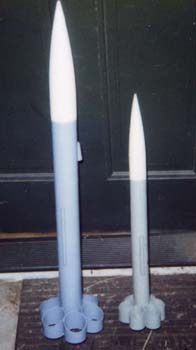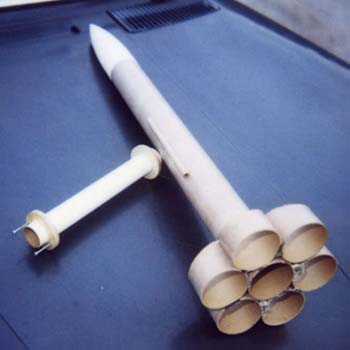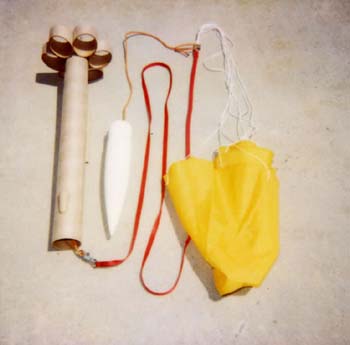Scratch Auracle 54 Original Design / Scratch Built
Scratch - Auracle 54 {Scratch}
Contributed by Larry Brand
| Manufacturer: | Scratch |
 Brief:
Brief:
This design is actually a scaled-up version of my tube-fin modification of the
LOC Aura (which I called
Auracle),
previously submitted to EMRR. I liked how easy to build and sturdy the original
was, and how well it flew in wind. I built the larger version (using a 54mm
tube as the airframe) as my Level One ship, thinking to fly it on an H128
instead of the E30-7 that flies the original (see photo). As it turned out, I
wound up qualifying with my back-up L1 ship, a
4"
38mm Goblin built from the EMRR article, since a generous offer of an H73
came my way. Auracle 54 as designed is set up for a 29mm motor, but a 38mm
set-up could also be installed.
Construction:
Auracle 54 is assembled from 54mm LOC tubing, the 6 tube fins having a 22.5
degree bevel top. Assembly sequence is exactly as for the smaller version, or
any tube-fin rocket. The 13" 29mm motor tube is installed with 1/4"
centering rings (photo). I originally used blind-nuts and washers for motor
retention, but have since switched to an Aeropak retainer. An optional LOC
6" payload compartment (built from their bulkhead kit) for my PerfectFlite
altimeter was built to interchange with the 54mm LOC nose cone (photo).
The recovery system used was fashioned from a PetCo 6' nylon dog leash with
18" of choke collar material attached via welded steel rings (photo). A
28" LOC chute attached with a mini carabiner completed the system. As in
all my rockets, the recovery system is anchored to the upper body with a knot
through the hull, covered with a plastic fairing (cut from a Garcia-Vega cigar
tube).
 The 1/4" launch lug is glued to align
with one of the spaces between 2 tube fins. The launch rod passed through both.
Finishing was with Flat Gray aircraft primer and flat flat white for the nose
cone/payload section. Final CG loaded with a G80 is 3.5" ahead of the
tube-fin tops, and Cp is somewhere inside the fin can, so Auracle 54 is overly
stable. The payload section version adds 85g of nose weight for flight with the
H128 set-up.
The 1/4" launch lug is glued to align
with one of the spaces between 2 tube fins. The launch rod passed through both.
Finishing was with Flat Gray aircraft primer and flat flat white for the nose
cone/payload section. Final CG loaded with a G80 is 3.5" ahead of the
tube-fin tops, and Cp is somewhere inside the fin can, so Auracle 54 is overly
stable. The payload section version adds 85g of nose weight for flight with the
H128 set-up.
Flight:
First flight was with an Aerotech G80-10, which was a perfect choice --
arrow-straight climb, ejection at about the 1500' -- 1700' and 270 mph
predicted by simulation (using a Cd of 1.0) -- and uneventful recovery.
Performance with a G40-7 was about the same, but with a slower climb. I have
finally acquired a few H128 reloads to go with my 29mm Dr. Rocket set-up, and
I'm looking forward to see what my Level One attempt with this design would
have looked like. For smaller fields, an F50-6 is a better choice, and gave
about 800' on the one I tried (simulation: 1050').
 Summary:
Summary:
Main PROs: Speed, ease and low cost of construction.
Excellent wind resistance. Cool looking if you like tube-fin designs. Sturdy.
Main CONs: High drag mitigates performance. Ugly looking if you hate tube-fin designs. Hard to get a good smooth finish on the cut edges of the tube fins.
Other:
I would like to think this would make a good Level One rocket but I won't know
until I try it on the H128. Simulation says it should hit about 1800' and no
more than 310 mph, so the risk of loss or overspeeding the airframe is minimal.
We'll soon know, because my six H128-M's are the only 29mm reloads I have left
until Aerotech recovers.
Sponsored Ads
 |
 |











